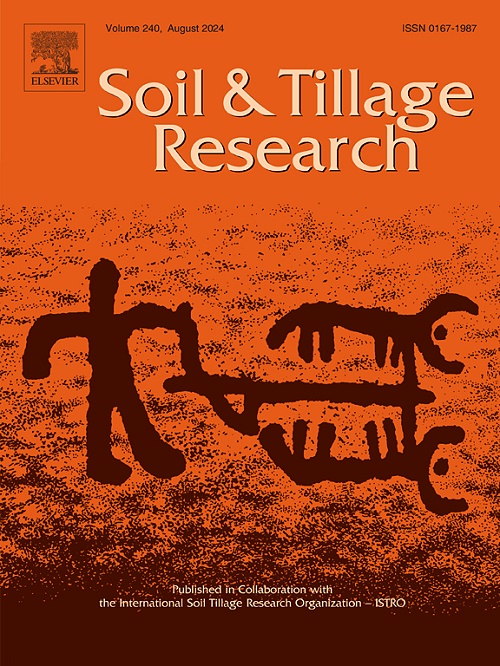Optimized straw incorporation depth can improve the nitrogen uptake and yield of rapeseed by promoting fine root development
IF 6.1
1区 农林科学
Q1 SOIL SCIENCE
引用次数: 0
Abstract
Nitrogen deficiency in early growth stages is known to enhance crop nitrogen uptake and yield by stimulating root growth. However, whether straw incorporation can induce similar effects by intensifying nitrogen competition between microorganisms and crops remains unclear. A six-year field experiment (2016–2022) investigated three straw management practices—shallow tillage (tillage depth of 10–15 cm) without straw incorporation (STS-), shallow tillage with straw incorporation (STS+), and moderate deep plowing with straw incorporation (MPS+, tillage depth of 20–25 cm)—on soil properties of clay loam, root structure, nitrogen uptake, and rapeseed (Brassica napus L.) yield. STS+ and MPS+ treatments significantly reduced soil bulk density and increased porosity, with MPS+ showing improvements across the 0–30 cm layer. Straw incorporation enhanced root length, surface area, and volume, particularly in the 0–0.5 mm diameter category, while reducing root diameter. STS+ and MPS+ increased root auxin and cytokinin levels and decreased abscisic acid content, enhancing root vitality. Nitrogen accumulation at maturity was significantly higher with straw incorporation, but accumulation patterns differed by incorporation depth. STS+ delayed the onset and termination of rapid nitrogen uptake, resulting in slow accumulation during the seedling stage and rapid uptake post-bolting, while MPS+ achieved a consistently higher nitrogen accumulation rate throughout the growth period. MPS+ increased nitrogen uptake by 18.5 %, leading to a 50.7 % yield increase, whereas STS+ showed no significant nitrogen uptake enhancement but increased yield by 21.2 %. Structural equation modeling suggested that straw incorporation enhanced nitrogen accumulation by promoting fine root growth in the 0–0.5 mm category, which in turn improved yield. Conversely, straw incorporation depth increased nitrogen accumulation by promoting root growth in the 0.5–2 mm and 0–0.5 mm diameter categories. These results indicate that MPS+ creates a moderately nitrogen-deficient environment during early growth stages, promoting fine root development, nitrogen uptake, and yield in rapeseed.
优化秸秆掺入深度可通过促进细根发育提高油菜籽的氮吸收率和产量
本文章由计算机程序翻译,如有差异,请以英文原文为准。
求助全文
约1分钟内获得全文
求助全文
来源期刊

Soil & Tillage Research
农林科学-土壤科学
CiteScore
13.00
自引率
6.20%
发文量
266
审稿时长
5 months
期刊介绍:
Soil & Tillage Research examines the physical, chemical and biological changes in the soil caused by tillage and field traffic. Manuscripts will be considered on aspects of soil science, physics, technology, mechanization and applied engineering for a sustainable balance among productivity, environmental quality and profitability. The following are examples of suitable topics within the scope of the journal of Soil and Tillage Research:
The agricultural and biosystems engineering associated with tillage (including no-tillage, reduced-tillage and direct drilling), irrigation and drainage, crops and crop rotations, fertilization, rehabilitation of mine spoils and processes used to modify soils. Soil change effects on establishment and yield of crops, growth of plants and roots, structure and erosion of soil, cycling of carbon and nutrients, greenhouse gas emissions, leaching, runoff and other processes that affect environmental quality. Characterization or modeling of tillage and field traffic responses, soil, climate, or topographic effects, soil deformation processes, tillage tools, traction devices, energy requirements, economics, surface and subsurface water quality effects, tillage effects on weed, pest and disease control, and their interactions.
 求助内容:
求助内容: 应助结果提醒方式:
应助结果提醒方式:


